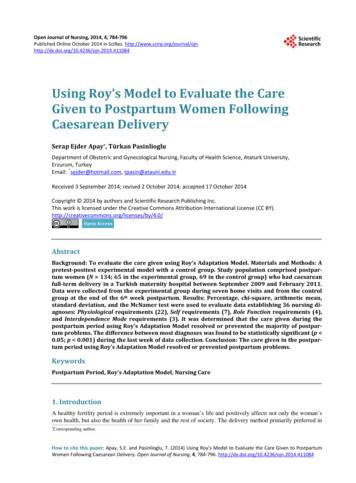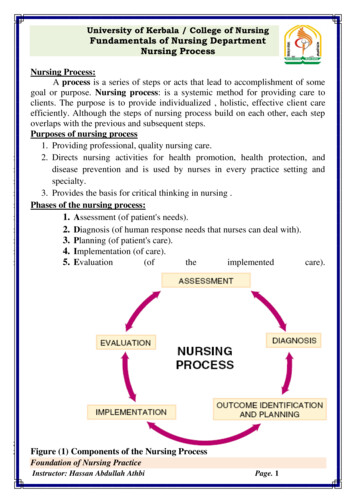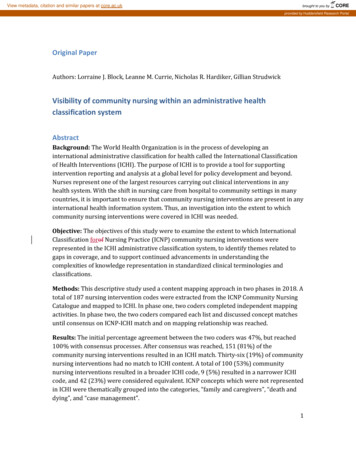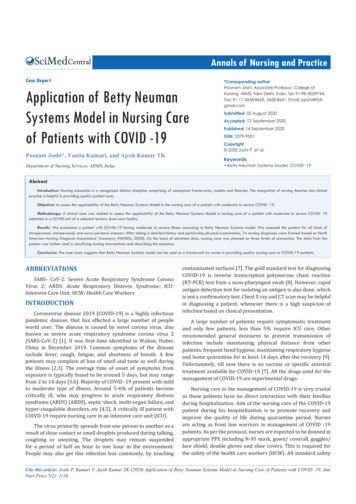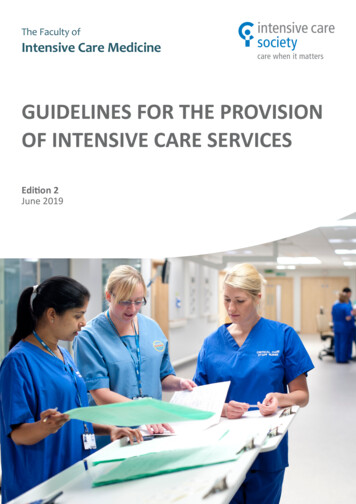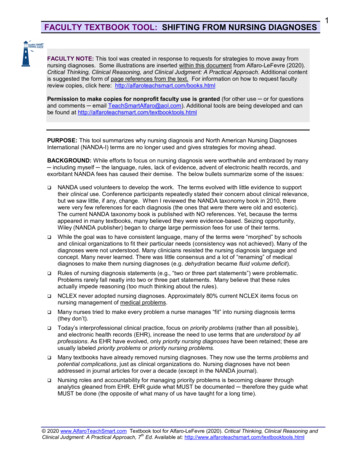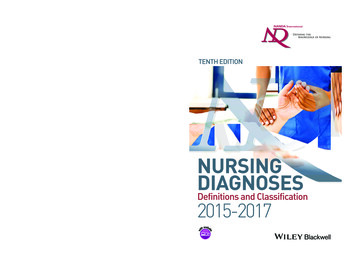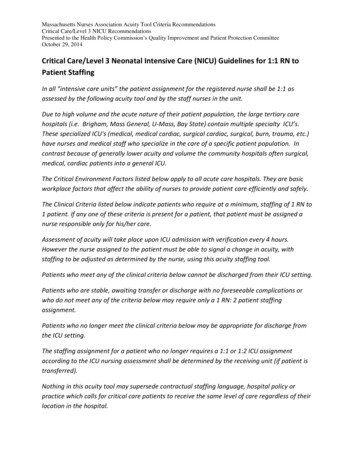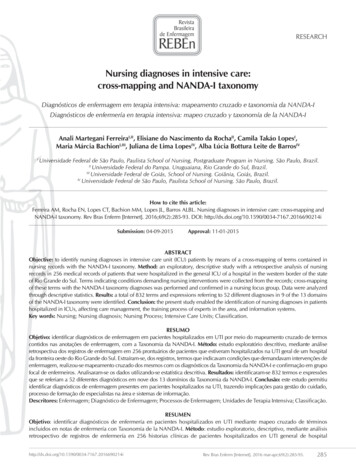
Transcription
RESEARCHNursing diagnoses in intensive care:cross-mapping and NANDA-I taxonomyDiagnósticos de enfermagem em terapia intensiva: mapeamento cruzado e taxonomia da NANDA-IDiagnósticos de enfermería en terapia intensiva: mapeo cruzado y taxonomía de la NANDA-IAnali Martegani FerreiraI,II, Elisiane do Nascimento da RochaII, Camila Takáo LopesI,Maria Márcia BachionI,III, Juliana de Lima LopesIV, Alba Lúcia Bottura Leite de BarrosIVIUniversidade Federal de São Paulo, Paulista School of Nursing, Postgraduate Program in Nursing. São Paulo, Brazil.IIUniversidade Federal do Pampa. Uruguaiana, Rio Grande do Sul, Brazil.IIIUniversidade Federal de Goiás, School of Nursing. Goiânia, Goiás, Brazil.IVUniversidade Federal de São Paulo, Paulista School of Nursing. São Paulo, Brazil.How to cite this article:Ferreira AM, Rocha EN, Lopes CT, Bachion MM, Lopes JL, Barros ALBL. Nursing diagnoses in intensive care: cross-mapping andNANDA-I taxonomy. Rev Bras Enferm [Internet]. 2016;69(2):285-93. DOI: mission: 04-09-2015Approval: 11-01-2015ABSTRACTObjective: to identify nursing diagnoses in intensive care unit (ICU) patients by means of a cross-mapping of terms contained innursing records with the NANDA-I taxonomy. Method: an exploratory, descriptive study with a retrospective analysis of nursingrecords in 256 medical records of patients that were hospitalized in the general ICU of a hospital in the western border of the stateof Rio Grande do Sul. Terms indicating conditions demanding nursing interventions were collected from the records; cross-mappingof these terms with the NANDA-I taxonomy diagnoses was performed and confirmed in a nursing focus group. Data were analyzedthrough descriptive statistics. Results: a total of 832 terms and expressions referring to 52 different diagnoses in 9 of the 13 domainsof the NANDA-I taxonomy were identified. Conclusion: the present study enabled the identification of nursing diagnoses in patientshospitalized in ICUs, affecting care management, the training process of experts in the area, and information systems.Key words: Nursing; Nursing diagnosis; Nursing Process; Intensive Care Units; Classification.RESUMOObjetivo: identificar diagnósticos de enfermagem em pacientes hospitalizados em UTI por meio do mapeamento cruzado de termoscontidos nas anotações de enfermagem, com a Taxonomia da NANDA-I. Método: estudo exploratório descritivo, mediante análiseretrospectiva dos registros de enfermagem em 256 prontuários de pacientes que estiveram hospitalizados na UTI geral de um hospitalda fronteira oeste do Rio Grande do Sul. Extraíram-se, dos registros, termos que indicavam condições que demandavam intervenções deenfermagem, realizou-se mapeamento cruzado dos mesmos com os diagnósticos da Taxonomia da NANDA-I e confirmação em grupofocal de enfermeiros. Analisaram-se os dados utilizando-se estatística descritiva. Resultados: identificaram-se 832 termos e expressõesque se referiam a 52 diferentes diagnósticos em nove dos 13 domínios da Taxonomia da NANDA-I. Conclusão: este estudo permitiuidentificar diagnósticos de enfermagem presentes em pacientes hospitalizados na UTI, trazendo implicações para gestão do cuidado,processo de formação de especialistas na área e sistemas de informação.Descritores: Enfermagem; Diagnóstico de Enfermagem; Processos de Enfermagem; Unidades de Terapia Intensiva; Classificação.RESUMENObjetivo: identificar diagnósticos de enfermería en pacientes hospitalizados en UTI mediante mapeo cruzado de términosincluidos en notas de enfermería con Taxonomía de la NANDA-I. Método: estudio exploratorio, descriptivo, mediante análisisretrospectivo de registros de enfermería en 256 historias clínicas de pacientes hospitalizados en UTI general de 0214iRev Bras Enferm [Internet]. 2016 mar-apr;69(2):285-93.285
Ferreira AM, et al.fronterizo del oeste de Rio Grande do Sul. Se extrajeron términos que indicaban condiciones demandando intervenciones deenfermería, se realizó mapeo cruzado de ellos con diagnósticos de Taxonomía de la NANDA-I y confirmación en grupo focalde enfermeros. Datos analizados aplicando estadística descriptiva. Resultados: se identificaron 832 términos y expresionesrelativos a 52 diagnósticos diferentes en 9 de los 13 dominios de Taxonomía de la NANDA-I. Conclusión: fue posible identificardiagnósticos de enfermería presentes en pacientes internados en UTI, con implicancias en la gestión de cuidado, en el procesode formación de especialistas en el área y en sistemas de información.Palabras clave: Enfermería; Diagnóstico de Enfermería; Procesos de Enfermería; Unidades de Cuidados Intensivos; Clasificación.CORRESPONDING AUTHORAnali Martegani FerreiraINTRODUCTIONIntensive care units (ICUs) are environments for hospitalization of patients in critical health conditions requiring specialized and continuous care(1). Therefore, nursing support in ICUsrequires quick and accurate identification of individual healthconditions by nurses because of patients’ severity and instabilityand complexity of the required care. The health care providedby the nursing team must be organized to share knowledge andcare strategies in order to promote the best outcomes to the patient along with other members of the team.In this context, the use of the Nursing Process as a methodto organize the clinical approach of the profession in ICUs favors the identification of patients’ conditions that require nursing interventions and more appropriate therapeutic decisionsto achieve outcomes within the nursing scope(2).Data collection is performed in the first stage of the Nursing Process and is an integral part of the diagnostic process(3).Nursing diagnosis (ND) - the second stage of the Nursing Process - consists of making clinical decisions on the presenceof a human response that requires nursing intervention; theassigned diagnosis is critical to define the care plan and expected outcomes(2,4).In this context, the special nursing languages, includingthe Nanda International Nursing Diagnoses (NANDA-I) taxonomy, play an important role, as they describe one of thephenomena of interest for the professional practice in a standardized way, pointing out possible areas of nursing contribution in the health care scenario.In certain regions of the country, the use of standardizedlanguages by nursing is still not common, possibly hindering the migration of manual records into computerized systems. In view of the Brazilian Health Informatics and Information Policy(5), one of the challenges of nursing consistsin producing information that is compatible with electronicrecord systems.Classification systems with standardized languages represent a set of structured knowledge and concepts organized ina logic way based on similarities(6). In this sense, the identification of ND profiles in populations can contribute to a betterdefinition and understanding of nursing as a discipline.Knowledge on the nursing diagnostic profile within astandardized language also contributes to subsidize actionsrelated to care, management, more appropriate design, andcontinuing education. Naming the conditions of ICU patientsrequiring nursing interventions contributes to strengthen286Rev Bras Enferm [Internet]. 2016 mar-apr;69(2):285-93.E-mail: analimf@gmail.comnurses’ professional identity based on a clear view of the phenomena that are taken into account in the field of nursing.Therefore, the aim of the present study was to identify nursing diagnoses in ICU patients through a cross-mapping of termscontained in nursing records with the NANDA-I taxonomy.METHODEthical aspectsThe research proposal was approved by the Research EthicsCommittee of the Federal University of São Paulo (UNIFESP).Study design, setting, and periodThis is a descriptive, exploratory study(7) of document analysis performed in the ICU of a general hospital in the westernborder of the state of Rio Grande do Sul, Brazil, from October2011 to April 2012. This institution does not use any ND standardized language. This period was defined due to the use ofunknown data which, in intervals below six months, couldhinder their identification(8-10).Population and sampleIn the first stage, the sample consisted of nursing recordscontained in the medical charts of patients in the studied scenario within the aforementioned period. The non-probabilisticintentional sample consisted of a total of 256 medical chartsof patients that were hospitalized in the ICU from October2011 to April 2012. In the second stage, the sample consistedof five clinical nurses that worked in the research setting –and that represented the totality of nurses in the ICU that metthe inclusion criteria: having clinical experience between 2and 10 years in the care of critically ill patients, and havingdeveloped care activities in the ICU within the period of datacollection.Selection of nurses met the criteria(11) that correlate thetime of clinical experience s with the levels of practicalknowledge. These criteria were used to divide the nursesinto five levels. The first level of knowledge characterizesnurses with clinical experience of up to six months as beginners; in this level nurses use protocols to determine theiractions(11). The second level includes nurses with practicalexperience in concrete situations with significant elements.The third level includes nurses that have a sense of whatis important in specific situations; they are able to interpret and analyze the patients’ situation. The fourth levelincludes proficient nurses that are able to identify goals
Nursing diagnoses in intensive care: cross-mapping and NANDA-I taxonomyand specificities of clinical situations and necessary interventions (as well as their redefinition whenever necessary)using previously acquired skills combined with practicalexperience and scientific knowledge(11). The fifth level ofknowledge includes nurses with 5 years of experience inthe domain area presenting intuitive judgment in decisionmaking processes in an accurate way; these nurses are characterized as experts(11). According to these criteria one nursewas classified as proficient and four nurses as experts(11).Study protocolThe study was developed in three stages: 1) Identificationof terms and expressions (compound terms) contained in nursing records of ICU patients indicating disorders, health conditions, life processes, motivation to increase well-being, andconditions of patient vulnerability requiring nursing interventions; 2) Cross-mapping of terms and expressions with the defining characteristics, related factors, risk factors, and labels ofnursing diagnoses approved by the NANDA-I classification; 3)Mapping validation through focus group with clinical nursesthat met the inclusion criteria.In the first stage the information contained in the nursingrecords of each medical chart was transcribed in full and uponin-depth and comprehensive reading for identification of concepts, terms, and expressions; simple (words) and compound(group of words) terms were identified, expressing conditionsdemanding nursing actions. These terms were grouped bysimilarities and association considering their context and content relevance in the corpus of the analysis. The content wasthen standardized(12).The following information was collected for the characterization of patients hospitalized in the ICU: gender, age, ethnicgroup, medical diagnosis, length of stay, educational level,profession, marital status, type of hospitalization (health insurance or private), and origin. The nursing records of eachmedical chart were transcribed to a standardized digital instrument created by the researchers and arranged in alphabetical order in electronic spreadsheets for fragmentation in termsand exclusion of repetitions. The instrument used to collectdata from medical charts consisted of the variables: type ofhealth insurance, number of registration and record of the patient in the institution, name of the patient, date of birth, age,gender, marital status, religion, profession, educational level,ethnic group, city of origin, date of admittance and discharge(or death), list of problems, and nursing records. Each instrument was identified by a number according to the sequenceof data collection.A cross-mapping of the terms identified in the nursing records with the defining characteristics (DCs) and related andrisk factors of the diagnoses approved by the NANDA-I classification was performed in the second stage.Mapping is defined as the process of explaining or expressing something through the use of words with equal or similarmeaning used to compare non-standardized nursing data withstandardized languages(6). This method enables comparisonsthat can be assessed among terms of different nursing languages to determine their semantic equivalence(8).The rules for cross-mapping used in this study were: 1) mapping using the context of NANDA-I nursing diagnoses classification; 2) seeking to ensure the meaning of the terms and expressions contained in the nursing records; 3) comparing thestandardized terms and expressions to the diagnostic focuses;4) correlating standardized terms and expressions that refer todiagnostic focuses present in the diagnostic concepts; 5) comparing and linking standardized terms and expressions withthe diagnostic concepts, defining characteristics, and relatedand risk factors of the diagnostic concepts (which containedthe previously identified diagnostic focuses); 6) identifyingand describing possible nursing diagnostic concepts; and 7)mapping the possible nursing diagnoses in the NANDA-I domains and classes(6).Cross-mapping enabled the identification of correspondingterms and expressions used in nursing records with the termsused in the NANDA-I classification. Disorders, health conditions, life processes, motivation to increase well-being, andconditions of vulnerability were presented by patients.In the third stage, these results were validated through afocus group meeting(13) involving five nurses. This techniqueenables data collection and qualitative assessment to determine the opinion of a group on a given subject(13).Four focus group meetings were conducted to reach consensus. During the meetings the nurses were asked whetherthey agreed, confirmed, and could remove or add informationrelated to the terms and expressions, diagnostic nursing labels, DCs, and related and risk factors. Therefore, lists containing the database of each patient and a copy of the NANDA-I2012-2014 classification book were provided to enable theanalysis.Analysis of resultsData were analyzed by means of descriptive statistics (absolute and percentage frequencies).RESULTSAmong the 256 records, 135 (52.7%) of the patients werewomen. Ages ranged between 15 and 96 years; 136 patients(53.1%) were aged over 60 years. Mean age was 58.95 years( SD 18.77) and median was 60.5 years.The analysis of the nursing records identified 1,118 termsindicating conditions requiring nursing interventions: disorders, health conditions, life processes, motivation to increasewell-being, and conditions of vulnerability were presented bypatients. After exclusion of repetitions a total of 832 terms andexpressions were collected to create the database of this study.The cross-mapping identified 52 different nursing diagnosticlabels as shown in Table 1 with an average of 4.6 diagnoses per patient distributed into 9 of the 13 domains of theNANDA-I taxonomy, with emphasis on the domains safety/protection, perception/cognition, elimination and change,and activity/rest.The ND Disturbed sensory perception: visual and kinesthetic was removed from the taxonomy of NANDA-I edition2012-2014. However, it is described in this edition with aRev Bras Enferm [Internet]. 2016 mar-apr;69(2):285-93.287
Ferreira AM, et al.review indication suggesting the development of studies toenhance its level of evidence.No diagnostic labels were identified in the domains 6 –Self-perception, 8 – Sexuality, 10 – Life principles, and 13– Growth/development. However, the nurses participating inthe focus group emphasized the need of the following diagnoses: Situational low self-esteem (00120), Domain 6 - Selfperception and Readiness for enhanced religiosity (00171),and Domain 10 – Life principles.Other unmapped diagnoses that were identified by the nurses of the focus group include: Ineffective health maintenance(00099) and Ineffective self-health management (00078), Domain 1 – Health promotion; Powerlessness (00125), and AdultTable 1 –failure to thrive (00101), Domain 9 – Coping/stress tolerance;Risk for falls (00155), Domain 11 – Safety and protection; andChronic pain (00133) and Domain 12 – Comfort.Thirty-nine (75%) nursing diagnostic labels identified are actual diagnoses and thirteen (25%) are risk diagnoses. Considering the domains, the most recurrent diagnoses were: Acute pain(n 146, 57.25%), Risk for infection (n 121, 47.45%), Impairedgas exchange (n 103, 40.39%), Decreased cardiac output(n 98, 38.43%), Acute confusion (n 35, 13.67%), Deficientfluid volume (n 26, 10.15%), and Anxiety (n 22, 8.59%).Table 2 presents the DCs and related and risk factors ofthe most frequent nursing diagnostic labels identified in themapping.Distribution of nursing diagnostic labels identified in patients hospitalized in an intensive care unit (N 256) according to the domains of NANDA-I taxonomy, Uruguaiana, Rio Grande do Sul, Brazil, October 2011 to April 2012DomainNANDA-I Nursing diagnostic labels and codes1. Health promotionIneffective protection (00043)1 (0.39)2. NutritionDeficient fluid volume (00027)26 (10.15)Risk for unstable blood glucose level (00179)12 (4.68)Excess fluid volume (00026)8 (3.12)Risk for electrolyte imbalance (00195)7 (2.73)Impaired swallowing (00103)6 (2.34)Imbalanced nutrition: less than body requirements (00163)3 (1.17)Imbalanced nutrition: more than body requirements (00001)1 (0.39)Risk for deficient fluid volume (00028)1 (0.39)Risk for imbalanced fluid volume (00025)1 (0.39)3. Elimination and exchange4. Activity/restImpaired gas exchange (00030)f (%)103 (40.23)Diarrhea (00013)17 (6.64)Impaired urinary elimination (00016)4 (1.56)Constipation (00011)3 (1.17)Dysfunctional gastrointestinal motility (00196)2 (0.78)Decreased cardiac output (00029)98 (38.28)Ineffective breathing pattern (00032)52 (20.31)Impaired bed mobility (00091)24 (9.37)Ineffective peripheral tissue perfusion (00204)21 (8.20)Impaired physical mobility (00085)17 (6.64)Risk for ineffective cerebral tissue perfusion (00201)8 (3.12)Disturbed sleep pattern (000198)5 (1.95)To be continued288Rev Bras Enferm [Internet]. 2016 mar-apr;69(2):285-93.
Nursing diagnoses in intensive care: cross-mapping and NANDA-I taxonomyTable 1 (concluded)5. Perception/cognition7. Role/relationships9. Coping/stress tolerance11. Safety/protectionFatigue (00093)3 (1.17)Insomnia (00095)2 (0.78)Risk for decreased cardiac tissue perfusion (00200)1 (0.39)Risk for ineffective gastrointestinal perfusion (00202)1 (0.39)Acute confusion (00128)35 (13.67)Impaired verbal communication (00051)21 (8.20)Risk for acute confusion (00173)20 (7.81)Unilateral neglect (00123)14 (5.46)Disturbed sensory perception: visual and kinesthetic (00122)*1 (0.39)Chronic confusion (00129)1 (0.39)Impaired memory (00131)1 (0.39)Dysfunctional family processes (00063)1 (0.39)Anxiety (00146)22 (8.59)Decreased intracranial adaptive capacity (00049)13 (5.07)Grieving (00136)2 (0.78)Risk for infection (00004)121 (47.26)Ineffective airway clearance (00031)75 (29.29)Impaired tissue integrity (00044)12. Confort64 (25)Hyperthermia (00007)46 (17.96)Risk for bleeding (00206)34 (13.28)Hypothermia (00006)15 (5.85)Impaired skin integrity (00046)14 (5.46)Ineffective thermoregulation (00008)13 (5.07)Risk for shock (00205)8 (3.12)Impaired oral mucous membrane (00045)6 (2.34)Risk for impaired skin integrity (00047)2 (0.78)Risk for suicide (00150)1 (0.39)Acute pain (00132)146 (57.03)Nausea (00134)14 (5.46)Impaired comfort (00214)1 (0.39)Note: * This diagnosis is presented in the edition 2012-2014 of the NANDA-I taxonomy for review.DISCUSSIONThe analysis of nursing records contained in the 256 medical charts of patients hospitalized in the ICU found 52 different diagnostic labels. While other studies simply analyzerecords to identify diagnoses in certain populations, this studyconducted a validation of the diagnoses with nurses of thesector that were able to add information to the records, consequently increasing the reliability of the results.In the domain Nutrition, the ND identified as the most recurrent was Deficient fluid volume. This diagnosis occurs insituations of hypovolemia, body-fluid depletion, trauma, andgastrointestinal bleeding due to ulcers and surgeries(14); thesesituations are common in patients hospitalized in ICUs. ARev Bras Enferm [Internet]. 2016 mar-apr;69(2):285-93.289
Ferreira AM, et al.Table 2 –Distribution of defining characteristics and related and risk factors of the most frequent nursing diagnostic labelsidentified in patients hospitalized in an intensive care unit (N 256) according to the NANDA-I domains . Uruguaiana, Rio Grande do Sul, Brazil, October 2011 to April 2012Domain/DiagnosisD2/ Deficient fluidvolume (00027)D3/ Impaired gasexchange (00030)D4/ Decreased cardiacoutput (00029)D5/ Acute confusion(00128)D9/ Anxiety (00146)Defining characteristicsf(%)Related or risk factorsDecrease in venous filling21 (8.20)Failure in regulatory mechanisms18 (7.03)Decrease in blood pressure20 (7.81)Active loss of fluid volume13 (5.07)Increase in pulse rate14 (5.46)Agitation37 (14.45)Changes in alveolar-capillarymembrane49 (19.14)Abnormal skin color (pale, dusky)33 (12.89)Imbalanced ventilation-perfusion28 (10.93)Tachycardia14 (5.46)Abnormal breathing (change in rate,frequency, depth)14 (5.46)Variations in pressure reading79 (30.85)Altered heart rate69 (27.95)Tachycardia48 (18.75)Altered afterload29 (11.32)Bradycardia37 (14.45)Altered stroke volume21 (8.20)Cold, clammy skin37 (14.45)Altered contractility12 (4.68)Fluctuation in cognition-level ofconsciousness35 (13.67)Dementia30 (11.71)Agitation07 (2.73)Age 60 years06 (2.34)Alteration in sleep-wake cycle05 (1.95)Increased discomfort04 (1.56)Fluctuation in psychomotor activity02 (0.78)Anxious17 (6.64)Altered health condition12 (4.68)Threat to health condition12 (4.68)Agitation08 (3.12)Increased breathing05 (1.95)Nervous04 (1.56)Insomnia04 (1.56)D11/ Risk for infection(00004)Invasive proceduresInappropriate primary defensesD12/ Acute pain(00132)Verbal report of pain117 (45.70)Observed evidence of pain59 (23.04)Altered blood pressure51 (19.92)Expressive behavior44 (17.18)study(15) identified the ND Deficient fluid volume in patientsvictims of trauma; the identified DCs were: increase in pulserate, decrease in blood pressure, decrease in venous filling;and one of the related factors was active loss of fluid volume(bleeding), a result also identified in the present study.290f(%)Rev Bras Enferm [Internet]. 2016 mar-apr;69(2):285-93.Harmful agents (biological,chemical, physical psychological)122 (47.65)16 (6.25)142 (55.46)In the domain Elimination and exchange, the presence ofthe diagnostic label Impaired gas exchange was identified,which was related to the presence of secretions in the airways and hindered proper gas exchanges to the use of ventilatory support and complications such as pulmonary edema
Nursing diagnoses in intensive care: cross-mapping and NANDA-I taxonomyand respiratory failure. This diagnosis was also identified inanother study with patients hospitalized in ICUs(16-17) with respiratory disorders. The DCs evidenced in these studies include shortness of breath on mild exertion and altered arterial blood gas (70%); also, during the physical examinationabnormal breathing was observed by alteredrate or depth, andtachycardia. Related factors found for this diagnosis include(16)ventilation-perfusion imbalance (100%) and alveolar-capillarymembrane changes (89%); these results are similar to the results found in the present study.In the domain Activity/rest, the most frequent ND was Decreased cardiac output, with Variations in pressure reading asthe most frequent DC and Altered heart rate as the relatedfactor. In a study(18) conducted with 51 patients hospitalizedin an ICU the ND Decreased cardiac output was identifiedin 45 (88.24%) patients; related factors identified include: altered contractility and rate, altered preload and afterload, andaltered heart rate. The ND Decreased cardiac output is associated with impaired myocardial function, which is related tothe presence of cardiovascular problems that lead to alterations in the cardiac output(19). These results were similar to theresults found in the present study, as cardiovascular problems(35.9%) were the most frequent problem according to thenursing notes of the studied patients.In the domain Perception/cognition the most frequent NDwas Acute confusion. In this study, this diagnosis was identified in patients presenting clinical conditions such as stroke,traumatic brain injury, and intracranial bleeding. This ND hasalready been identified in patients victims of trauma(15) withevidence indicating occurrence of great magnitude in populations above 60 years old(15,20).In the domain Coping/stress tolerance, the ND Anxiety wasthe most frequent. This diagnosis makes up the human responses of coping. A study(9) found that patients hospitalized in ICUsexperience stressful situations, such as fear of dying because ofthe environment that inflicts tension and contributes to increaseanxiety. A study(21) to validate the DCs of the ND Anxiety in patients with chronic heart failure identified DCs similar to thosefound in this study, including discomfort and insomnia.In the domain Safety/protection, the ND Risk for infectionwas identified; the most frequent risk factor was Invasive procedures. Predisposing factors for the occurrence of this NDwere related to venous access puncture, use of orotrachealtube, mechanical ventilation therapy, use of tracheostomy,use of drains, surgical incisions, insertion of gastric and vesical probes, and skin lesions with skin breakdown and tissuedestruction. Risk for infection in elderly patients is associatedwith physiological changes of aging, particularly in the immune system, and delay in the tissue healing process(22). Considering that length of stay may expose patients to invasivediagnostic exams and procedures, these factors contribute to ahigh risk for infections(22).The presence of the ND Risk for infection was identified inpatients who were using mechanical ventilation, orotrachealtube, tracheostomy, and airways suction. These situations increase the risk for infection as patients in such circumstancesdo not have normal upper airway defenses (23).Acute pain was identified as the most frequent ND in the domain Comfort. The DCs and related factors were the same described in other research(19,24). Verbal report of pain was pointedout as the main DC identified by nurses in the studied ICU to indicate the existence of pain. Verbal response may be spontaneousor requested and may refer to sensory, emotional, or cognitive aspects to characterize the painful experience, being characterizedas gold-standard to the assessment of this symptom(2,25).In the domains Health promotion and Roles/relationships,the identified diagnoses presented lower frequency. In addition, no diagnoses were mapped in the domains Self-perception, Sexuality, and Life principles. A study performed in anICU in the southern region of Brazil(26) found no psychosocialor psychospiritual needs approached by nurses, although theauthors expected such results considering the severity and imminent risk to life of the ICU. This would prioritize psychobiological needs and the consensus to know that there are alteredpsychosocial needs such as social isolation and communication problems in the context of ICUs.In the present study, the nurses confirmed, through thefocus group, the presence of disorders in the domains Selfperception and Life principles, although there were no records in the medical records pointing out the identificationof diagnoses in these domains. Thus, it is worth noting theimportance of registering its presence(27). For the domain Sexuality, there was no identification of diagnoses. These findingsare believed to be related to health specificities of patientshospitalized in the studied ICU, in which the human responseSexuality may not be prioritized.Knowing the diagnostic profile in light of a standardizednursing language assists in the organization of managementand care nursing actions. As the NDs, DCs, and related andrisk factors identified in the studied ICU converge to datafound in the literature it is possible to visualize the set of phenomena to which the attention of the profession is focusedin the context of intensive therapy and for the resolution orprevention of which interventions must be planned. Aware ofthe interventions to be implemented, nurses may, in advance,plan direct care activities, identify the workforce needed toimplement them, and understand the needs of qualification/improvement of the team. Knowing the diagnoses enable thecreation of assessment protocols to reduce the number of incomplete records that may contribute to failures in health care;and this may also assist in the qualification of health care(28).CONCLUSIONThis study enabled the identification of clinical situationsrequiring nursing interventions and the verification of theirequivalence with 52 NANDA-I nursing diagnostic labels.Considering the domains, the most recurrent diagnoses were:Acute pain, Risk for infection, Impaired gas exchange, Decreased cardiac output, Acute confusion, Deficient fluid volume, and Anxiety.In the clinical practice, the identified ND can subsidizethe development of a nursing data collection instrument forpatients hospitalized in intensive care units. They
relativos a 52 diagnósticos diferentes en 9 de los 13 dominios de Taxonomía de la NANDA-I. Conclusión: fue posible identificar diagnósticos de enfermería presentes en pacientes internados en UTI, con implicancias en la gestión de cuidado, en el proceso de formación de especialistas en el área y en sistemas de información.
